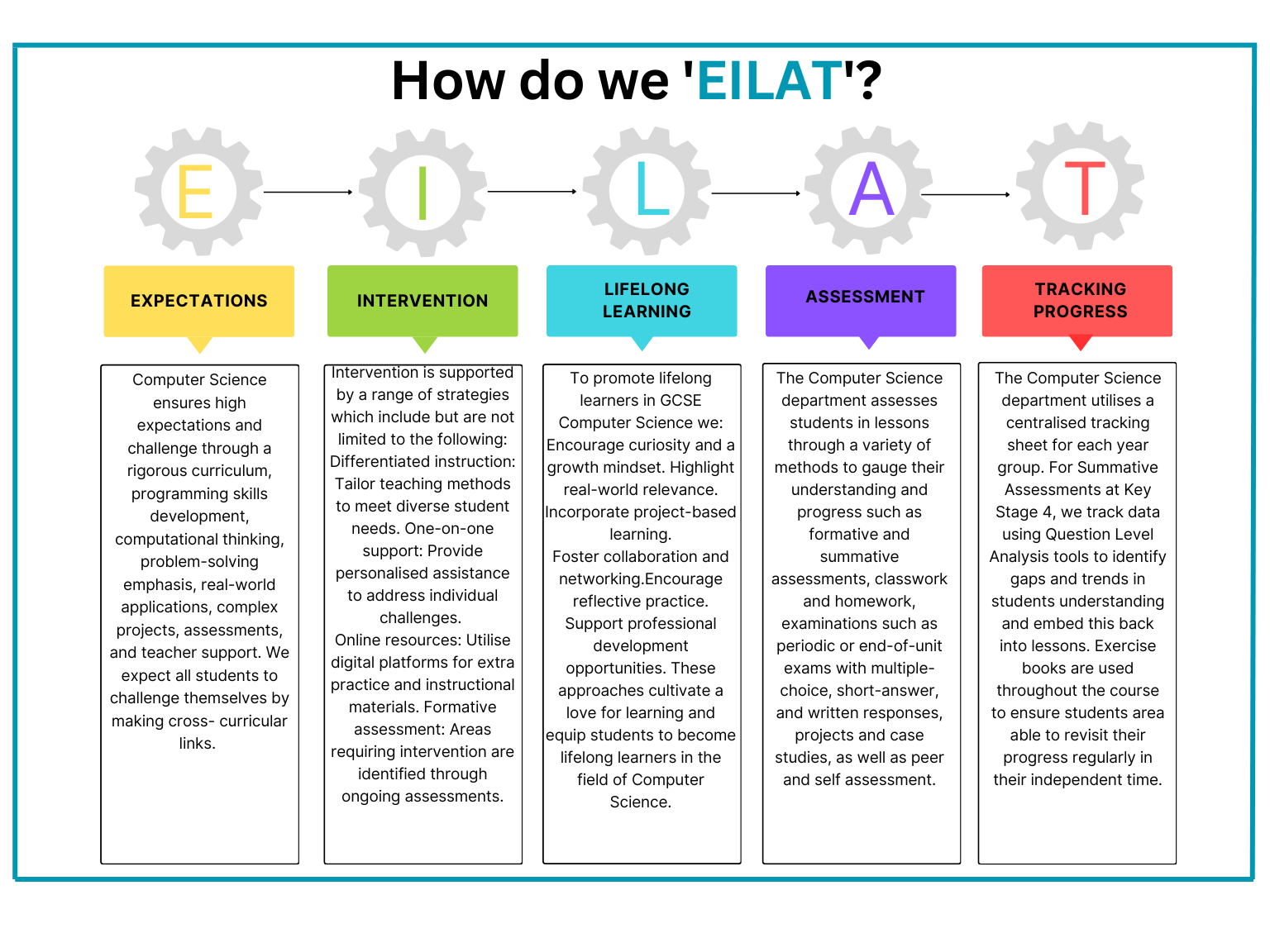- Home
- Curriculum
- Subjects
- Computer Science
Computer Science
'Computer Science is a discipline that seeks to understand and explore the world around us, both natural and artificial, in computational terms'
Intent
The study of Computer Science at Jubilee High School aims to:
- Encourage our students to play an active role in the digital world that surrounds them, not to be passive consumers of an opaque and mysterious technology. Understanding the digital world will allow students to remain safe online.
- Provide students with the means to access the theoretical foundations, mathematical underpinnings, and application of logic and reasoning.
- Provide students with the means to design, construct, and test purposeful digital artefacts. To implement the use of computer systems, and understand the principles underlying these designs.
- Empower our students with a set of computational thinking skills and a computational approach to problem solving. Providing them with the ability to solve these practical problems is central to the success of science, engineering, business and commerce in the 21st century.
- Provide students with the means to understand Computing as a quintessential STEM discipline that shares attributes with engineering, mathematics, science, and technology.

Meta-concepts
The following meta-concepts underpin our curriculum:
- Active & Safe- Online safety is a key part of Y7 term 1. All Y7 pupils take an online course on E-Safety with the aim for them to receive a certificate at the end. This is completed in class and via homework. This also embeds key school systems, applications and processes.
- Logic & Reasoning- In Y7 we teach Scratch and MicroBits using block code to familiarise pupils with the fundamental of programming, algorithms and problem solving. This is built on in Y8 with Computational Thinking, Flowchart (using Flowol to simulate real-life systems) and then Python programming.
- Design & Build- Creating programs in Scratch, MicroBits and Python, and flow diagrams using Flowol.
- Computational Thinking- Using Computational Thinking to solve real world problems and the life skills of decompositions, abstraction and algorithms. Apply these to programming and other problem-solving activities.
- STEM- Mathematics is used throughout the course in coding to get the computer to perform calculations, to data sizes, binary and programs to solve problems (turtle to draw geometric shapes, calculate area etc.) We also look at a range of systems and topics covering networks, radio waves (wi-fi), sound waves (sound), light etc.
Computer Science curriculum sequence
Implementation
Key Stage 3
The Computing curriculum is delivered through one hour lessons per week in year 7, 8 and 9. We teach our year 9 students elements of the Business Studies syllabus as there are established fusion of the two subjects such that the Business modules are delivered by making full use of computing systems and practices. This gives students relevant experience when choosing KS4 options.
The structure of our KS3 curriculum is underpinned by fundamental principles and concepts of Computer Science, including abstraction, logic, algorithms and data representation. These are not merely taught as discrete disciplines but rather they form the basis of various modules strategically interspersed across Year 7 to 9 and beyond. This allows us to support retrieval and spaced practice. These approaches are well-supported by evidence.
Year 7 and 8- Online safety is taught as a discrete module in year 7 and further age appropriate ‘top-ups’ are provided in subsequent Years when relevant. In year 7 and 8 students complete modules on coding, algorithms and problem solving using flow charts in a software package called ‘Flowol’.
Year 9- In year 9 pupils apply the aforementioned skills whilst studying an extended computer science project. In this module they now implement their computational thinking developed over the previous two years by planning, testing and implementing their coding knowledge in case studies. This requires students to demonstrate not only computational thinking but also tenacity and resilience; essential ingredients for lifelong independent learning.
Key Stage 4
The year 10 and 11 Computer Science curriculum is very much pupil centric, where students have six hours per fortnight. At Key Stage 4, the course builds on the knowledge, understanding and skills established during years 7 and 8. There is a heavy focus on programming skills and students are given the opportunity to experiment with a variety of languages and activities.
During year 11, students continue to study the exam board specification theory units and revisit theory already covered in the form of written and multiple-choice topic assessments. A programming project is undertaken which involves students analysing a programming problem, designing a solution and implementing their design. Completing the project gives students relevant experience they can relate to in the Component two exam.
This leads pupils, including the ones with the most complex needs, to demonstrate willingness to deepen their learning and resilience while tackling tasks and learning concepts, which are incrementally challenging year after year.

GCSE specification- Computer Science
Impact
The Computer Science curriculum sequence allows for the teaching of theory followed by application of the theory in the form of practical lessons and homework. The impact of following these protocols is that students enjoy a familiar learning experience and know what is expected of them in each lesson. Formative assessment is ongoing during projects and programming tasks, and summative assessment is used during end of topic assessments.
This allows students to know what level they are working at, and provides them with the knowledge of how they can achieve their full potential.



